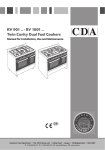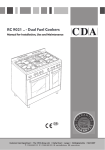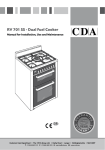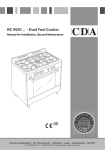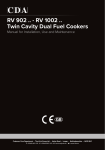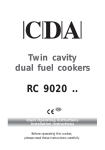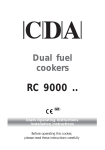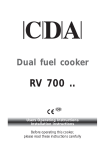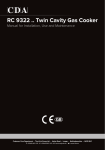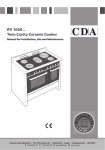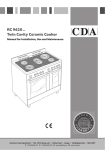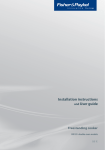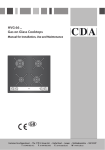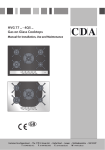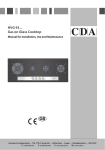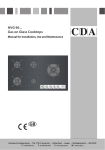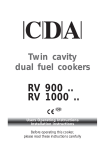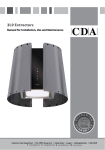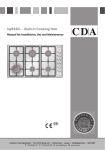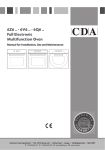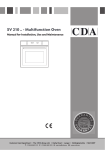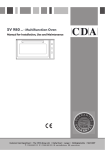Download RV 1200 .. - Dual Fuel Cooker
Transcript
RV 1200 .. - Dual Fuel Cooker Manual for Installation, Use and Maintenance GB Customer Care Department • The Group Ltd. • Harby Road • Langar • Nottinghamshire • NG13 9HY T : 01949 862 012 F : 01949 862 003 E : [email protected] W : www.cda.eu 2 Important This appliance is designed and manufactured solely for the cooking of domestic (household) food and is not suitable for any non domestic application and therefore should not be used in a commercial environment. The appliance guarantee will be void if the appliance is used within a non domestic environment i.e. a semi commercial, commercial or communal environment. The CDA Group Ltd cannot be held responsible for injuries or losses caused by incorrect use or installation of this product. Please note that CDA reserve the right to invalidate the guarantee supplied with this product following incorrect installation or misuse of the appliance. Appliance information: Please enter the details on the appliance rating plate below for reference, to assist CDA Customer Care in the event of a fault with your appliance and to register your appliance for guarantee purposes. Appliance Model Serial Number Declaration of CE conformity This cooker has been designed, constructed and marketed in compliance with: - Safety requirements of EU Directive “Gas” 2009/142/EC; - Safety requirements of EU Directive “Low Voltage” 2006/95/EC; - Protection requirements of EU Directive “EMC” 2004/108/EC; - Requirements of EU Directive 93/68/EEC. Important information for correct disposal of the product in accordance with EC Directive 2002/96/EC. At the end of its working life, the product must not be disposed of as urban waste. It must be taken to a special local authority differentiated waste collection centre or to a dealer providing this service. Disposing of a household appliance separately avoids possible negative consequences for the environment and health deriving from inappropriate disposal and enables the constituent materials to be recovered to obtain significant savings in energy and resources. As a reminder of the need to dispose of household appliances separately, the product is marked with a crossed-out wheeled dustbin. 3 Features and Technical Data Cooking Hob 1. Semi-rapid burner (SR) 2. Triple-ring burner (TR) 3. Dual burner (D) 4. Ceramic griddle 1,75 kW 3,50 kW 4,20 kW 1300 W Note: The electric ignition is incorporated in the knobs. The appliance has a safety valve system fitted, the flow of gas will be stopped if and when the flame should accidentally go out. Attention: Do not use the appliance if the glass surface of the ceramic griddle is broken or cracked in any way. Please disconnect the appliance from the mains and contact the after-sales service. 4 3 1 1 2 2 Multifunction Main Oven Fig. 1 Conventional Oven Fan Oven Storage Drawer 4 Control Panel Controls Description 1. Conventional oven thermostat knob (Top left oven) 2. Conventional oven switch knob (Top left oven) 3. Fan oven thermostat knob (Lower left oven) 4. Fan oven switch knob (Lower left oven) 5. Front left triple-ring burner control knob 6. Rear left semi-rapid burner control knob 7. Central dual burner control knob 8. Ceramic griddle control knob 9. Rear right semi-rapid burner control knob 10. Front right triple-ring burner control knob 11. Clock and timer with “Touch-Control” keys (Right main oven only) 12. Multifunction oven switch knob (Right main oven) 13. Multifunction oven thermostat knob (Right main oven) 14. Indicator light (Right main oven) 15. Ceramic griddle control lamp 16. Indicator light (Lower left oven) 17. Indicator light (Top left oven) Please note: This appliance incorporates no. 2 (two) safety cooling fans which you will hear operating whenever the oven or grill are in use. The cooling fans may also operate when the oven is switched off. These fans are to reduce the external temperature of the appliance and cool the internal components. 17 1 Fig. 2 16 2 3 15 4 5 6 7 8 14 9 10 11 12 13 5 Clock and Timer with “Touch-Control” Keys (Multifunction Main Oven only) Keys: + and – Touched simultaneously (for more than 2 seconds): • setting the clock; • setting the timer volume (by touching once, along with the “MODE” key); • to cancel automatic cooking at any time. MODEFunction selection (touched for more than 2 seconds): • setting the clock (only after first connection or after a power failure); • timer; • automatic cooking “dur” (duration) - how long the food will take to cook (by touching the “MODE” key again); • automatic cooking “End” - the time you would like the oven turns off (by touching the “MODE” key two more times); + Increases the number shown on the display – Decreases the number shown on the display Fig. 3 Illuminated Symbols: AUTO flashing - Automatic cooking completed, oven in automatic position but not set AUTO steady illumination - Oven set for automatic cooking, cooking still not taking place “ ” flashing - Timer being set “ ” steady illumination - Timer in operation “ ” steady illumination - Oven set for manual cooking “ ” and AUTO AUTO flashing - Automatic cooking being set “ ” and AUTO steady illumination - Oven set for automatic cooking, cooking taking place. 6 “Touch-Control” Keys The “touch-control” keys shall be operated by the fingers (just by touching the key). When using touch controls it is best to use the ball of your finger rather than the tip. The keys are automatically deactivated: - 8 seconds after the last selection; the deactivation is indicated by an acoustic signal (“beep”). To reactivate just touch the “MODE” key or the “+” and “–” keys. Setting the Clock When first connected, or after a power failure, the digits and “AUTO” will shown on the display. To set the clock, touch the “MODE“ key, for more than 2 seconds, and then the “+” or “–” keys. Important: The oven does not operate, in manual cooking, without first having set the clock. To set the clock, with the appliance already connected, touch the “+” and “–” keys simultaneously (for more than 2 seconds), then “+” or “–” keys. Important: - changing the time will delete any automatic program; - after setting the clock, the oven starts to operate in the selected function (manual cooking). The “ ” symbol is steady illuminated. Using the Timer You can use the timer at any time, even when the oven is not in use. The timer does not turn the oven off. The timer can be set for up to 23 hours and 59 minutes. - To set the timer, touch the “MODE” key for more than 2 seconds (the “ ” symbol flashes), than the “+” or “–” keys. - After about 8 seconds an acoustic signal (“beep”) will sound confirming the regulation (“ ” symbol steady illuminated). - To check the remaining time touch the “MODE“ key for more than 2 seconds. If the remaining time is more than a minute the display will show hours and minutes; if less than a minute the display will show seconds. - When the time is up, the timer will beep. Touch the “MODE” key , for more then 2 seconds, to turn it off; or press the “+” or “–” key to stop the beep and than the “MODE” key, for more than 2 seconds, to deactivate the “ ” symbol flashing on the display. - Turn off the oven manually (function and thermostat knobs in the off position) if the manual cooking has been completed. 7 Setting the Timer Volume You can select from three volume levels. - Touch the “+” and “–” keys simultaneously for more than 2 seconds. - Touch the “MODE” key; you can read on the display the current timer volume (“ton1”, “ton2” or “ton3”). - Touch the “–” key to listen or change the timer volume. - Timer volume activated: the last displayed. - After about 8 seconds an acoustic signal (“beep”) will sound confirming the volume setting; then the time of day will be displayed. Automatic Cooking Use automatic cooking to automatically turn the oven on, cook, and then turn the oven off. 1. Check the clock shows the correct time. 2. Select the function and temperature (function and temperature knobs). The oven will come on. 3. Decide how long the food will take to cook, allowing time for preheating if necessary. 4. Touch the “MODE” key for more than 2 seconds and then touch again. “dur” will show (duration). Using the “+” and “–” keys, set the stop time. 5. Decide the time you would like the oven to turn off; touch the “MODE” key for more than 2 seconds and then touch it two times again. “End” will show. Using the “+” and “–” keys, set the stop time. Note: While “dur” is displayed you can change to “End” just by touching one time the “MODE” key (within 8 seconds from the last selection). If there is time to wait before cooking starts, the current time of day and “AUTO” will show in the clock display. The oven will switch off but is now set for automatic cooking. If you are already at home to turn the oven on and only want the oven to turn off automatically, start cooking as normal, then follow step 4 or step 5 to set a time to stop the oven. When automatic cooking starts, “ ” will be displayed and the oven will turn on. - To see the remaining cook time, follow step 4 up to display “dur” (duration). - To see the set stop time, follow step 5 up to display “End”. - To cancel automatic cooking at any time, touch the “+” and “–” keys simultaneously (for more than 2 seconds) and turn the temperature and function knobs to the off position. When the stop time is reached, the oven will turn off, the timer will beep and “AUTO” will flash: - Touch any key to stop the beeping. - Touch the “MODE” key, for more than 2 seconds, to return the oven to the manual mode (“ ” symbol steady illuminated on the display). - Turn the temperature and function knobs to the off position. Attention: after a power failure any automatic program is deleted. Turn off the oven manually. 8 How to Use the Hob Burners Semi-rapid and Triple-Ring Gas Burners Gas flow to the burners is adjusted by turning the knobs (illustrated in fig. 4) which control the valves. Turning the knob so that the indicator points to the symbol printed on the control panel achieves the following functions. The maximum aperture position permits rapid boiling of liquids, whereas the minimum aperture position allows simmer warming of food or maintaining boiling conditions of liquids. To reduce the gas flow to minimum, rotate the knob further anti-clockwise to point the indicator towards the position (minimum rate). Other intermediate operating adjustments can be achieved by positioning the indicator between the maximum and minimum aperture positions, and never between the maximum aperture and position. Knob position Function Closed valve Maximum rate Minimum rate Semi-Rapid Burner Triple Ring Burner 9 Lighting Semi-Rapid and Triple-Ring Gas Burners, Fitted with Flame Failure Safety Device In order to light the burner, you must: 1 – Push and turn the knob in an anti-clockwise direction up to the position (maximum rate), push in and hold the knob until the flame has been lit (fig. 4). The sparks produced by the lighter situated inside the relative burner will light the flame. In the event that the local gas supply conditions makes it difficult to light the burner in the position (maximum rate), try again with the knob in position (minimum rate). If there is no mains electrical supply, bring a lighted match close to the burner. 2 – Wait for about ten seconds after the gas burner has been lit before letting go the knob (safety device activation delay). 3 – Adjust the gas valve to the desired position. Fig. 4 Important If the burner flame should go out for some reason, the safety valve will automatically stop the gas flow. To re-light the burner, return the knob to the closed position, wait for at least 1 minute and then repeat the lighting procedure. N.B. When the cooker is not being used, set the gas knobs to their positions and also close the gas shut-off valve placed on the main gas supply line. Caution! The cooker becomes very hot during operation. Keep children well out of reach. 10 Dual Gas Burner The Dual Burner is a very flexible burner which allows different regulations and optimal cooking. It is composed by one inner and two outer crowns; the flame of the inner crown can be regulated separately from the flames of the outer crowns. The Dual Burner can be used: - as a small burner (flame produced only by the inner crown) which can be adjusted from the maximum ( ) to the minimum ( ) position. Intermediate operating adjustments can be achieved by positioning the indicator between the maximum and minimum opening positions, and never between the maximum opening and position. - as a high-power burner (all flames produced simultaneously by inner and outer crowns) which can be adjusted from the maximum ( ) to the minimum ( ) position. Gas flow to the burner is adjusted by turning the knob (illustrated in fig. 5) which controls the valve. Turning the knob so that the indicator points to the symbol printed on the control panel achieves the following functions: Knob position Function Closed valve Maximum rate of inner crown (only inner flame at the maximum) Minimum rate of inner crown (only inner flame at the minimum) Maximum rate of inner + outer crowns (inside and outside flames in simultaneously at the maximum) Minimum rate of inner + outer crowns (inside and outside flames in simultaneously at the minimum) Dual Burner 11 Lighting Dual Gas Burner, Fitted with Flame Failure Safety Device In order to light the burner, you must: 1 – Push and turn the knob in an anti-clockwise (fig. 5) direction up to the position (maximum rate of inner and outer crowns); push in and hold the knob until the flame has been lit. The sparks produced by the lighter situated inside the relative burner will light the flame. In the event that the local gas supply conditions makes it difficult to light the burner in position, try again with the knob in position. If there is no mains electrical supply connection, bring a lighted match close to the burner. 2 –Wait for about ten seconds after the gas burner has been lit before letting go the knob (safety device activation delay). 3 –Adjust the gas valve to the desired position. If the burner flame should go out for some reason, the safety valve will automatically stop the gas flow. To re-light the burner, return the knob to the closed position ( ), wait for at least 1 minute and then repeat the lighting procedure. Note: To change from using the inner crown only to using both the inner and outer crowns together, press the control knob down before turning it. You have to do the same when going from using both crowns to using just the inner crown. Fig. 5 N.B. When the cooker is not being used, set the gas knobs to their positions and also close the gas shut-off valve placed on the main gas supply line. Caution! The cooker becomes very hot during operation. Keep children well out of reach. 12 Choice of Burner The burner must be choosen according to the diameter of the pans and energy required. Saucepans with handles which are excessively heavy, in relationship to the weight of the pan, are safer as they are less likely to tip. Pans which are positioned centrally on burners are more stable than those which are offset. It is far safer to position the pan handles in such a way that they cannot be accidentally knocked. When deep fat frying fill the pan only one third full of oil. DO NOT cover the pan with a lid and DO NOT leave the pan unattended. In the unfortunate event of a fire, leave the pan where it is and turn off all controls. Place a damp cloth or correct fitting lid over the pan to smother the flames. DO NOT use water on the fire. Leave the pan to cool for at least 30 minutes. Do not use pans with concave or convex bases Fig. 6 Burner Size Minimum Pan Diameter (cm) Maximum Pan Diameter (cm) Semi-Rapid 16 24 Triple Ring 26 28 Dual 26 28 Wok pans - 36 13 Correct Use of Triple-Ring and Dual Burners The flat-bottomed pans are to be placed directly onto the pan-support. To use the WOK you need to place the proper stand in order to avoid any faulty operation of the triplering (figs. 7a - 7b) and dual burner (figs. 8a - 8b). Important: The wok pan stand (figs. 7b - 8b) MUST BE PLACED ONLY over the pan-rest for the triplering burner and dual burner. WRONG CORRECT Fig. 7b Fig. 7a WRONG Fig. 8a CORRECT Fig. 8b 14 How to use the ceramic griddle The griddle reaches the working temperature very quickly and can grill any food, without fat and oil, directly on the radiant zone's glass-ceramic surface. Operation of the radiant zone is controlled by a continuous 12-position power regulator. The signal lamp lights up when the griddle is ON. Using the Ceramic Griddle for the First Time – Remove the adhesive film which protects some parts. – Remove any residual glue carefully, without using abrasive substances, to avoid scratching the surfaces. – Clean the cooking surface carefully. – Switch the griddle on by turning the power setting knob (fig. 9) to the maximum position (11-12) for about 15 minutes to remove residual working greases. Use of the Ceramic Griddle – Before cooking make sure that the radiant zone is clean. – Switch the griddle on by turning the knob to position 12. – Preheat until the cooking surface becomes red. – Then turn the knob to the position required. The numbers from 1 to 12 indicate the working positions with temperature increasing as the number increases. – Place the food on the radiant zone and check the cooking by eye. – Turn off the griddle by turning the knob to position “ ”. – As the radiant zone remains hot for some time after the hob is switched off, turn the zone off a few minutes before the end of cooking. The residual heat will complete the cooking. – Do not use the griddle for more than 30 minutes. Fig. 9 15 Tips for Grilling: – Preheat the radiant zone sufficiently to obtain quick and uniform cooking. – Do not pour water on the cooking surface when it is switched on or still hot. – If cooking very fatty foods, leave the griddle switched on for a few minutes after cooking is finished, to burn off the fatty residues. Advice for the Safe Use of Ceramic Griddle Caution! – Do not lean on the cooking zone when it is switched on. – Do not put aluminium foil or plastic objects on the cooking zone when it is hot. – Do not leave objects of any type on the surfaces made of ceramic, glass or similar fragile material. – Remember that the cooking zone remains hot for some time after it is switched off (about 30 min.). – Follow the cleaning instructions carefully. – If you note a crack in the glass-ceramic surface, switch the appliance off immediately and call the After-Sales Service. The griddle becomes very hot during use and remains very hot even after it is switched off. Cleaning the Ceramic Griddle Make sure that the ceramic griddle is switched off before cleaning it. – Remove any encrustation. – Remove dust with a damp cloth. – Detergents can be used, but they must not be abrasive or corrosive. – Any remaining detergent must be completely removed with a damp cloth. – Do not put any objects on the ceramic surface which can melt with heat, such as plastic objects, aluminium foil, sugar or sugar products. – If any object melts on the ceramic surface, remove it immediately (while the ceramic griddle is still hot) using a special scraper, to prevent any irreversible damage to the glass ceramic surface. – Do not use knives or sharp objects which could damage the ceramic surface. – Do not use abrasive sponges or pads which could irreversibly damage the glass ceramic surface. Keep children well out of reach. Do not scratch the cooktop with cutting or sharp objects. Do not use the cooktop as a work surface. CAUTION: Never use abrasive substances or no-neutral detergent which could irreversibly damages. 16 How to Use the Multifunction Oven (Right Main Oven) General Features As its name indicates, this is an oven that presents particular features from an operational point of view. In fact, it is possible to insert 7 different programmes to satisfy every cooking need. The 7 positions, thermostatically controlled, are obtained by 4 heating elements which are: – Bottom element 1300 W – Top element 1000 W – Grill element 2000 W – Circular element 2200 W Attention: The oven door becomes very hot during operation. Keep children away. Note: Upon first use, it is advisable to operate the oven for 30 minutes in the position and for another 15 minutes at the maximum temperature (thermostat knob on position 250) in the positions and , to eliminate possible traces of grease on the heating elements. Clean the oven and accessories with warm water and washing-up liquid. WARNING: The door is hot, use the handle. ATTENTION - MOST IMPORTANT Pay special attention not to touch the hot heating element inside the oven cavity. Operating Principles Heating and cooking in the MULTI-FUNCTION oven are obtained in the following ways: a. by normal convection The heat is produced by the upper and lower heating elements. b. by forced convection A fan sucks in the air contained in the oven muffle, which sends it through the circular heating element and then sends it back through the muffle. Before the hot air is sucked back again by the fan to repeat the described cycle, it envelops the food in the oven, provoking a complete and rapid cooking. It is possible to cook several dishes simultaneously. c. by semi-forced convection The heat produced by the upper and lower heating elements is distributed throughout the oven by the fan. d. by radiation The heat is radiated by the infra red grill element. e. by radiation and ventilation The irradiated heat from the infra red grill element is distributed throughout the oven by the fan. f. by ventilation The food is defrosted by using the fan only function without heat. 17 Thermostat Knob (fig. 11) This only sets the cooking temperature and does not switch the oven on. Rotate clockwise until the required temperature is reached (from 50 to 250°C). The thermostat indicator light will illuminate when the oven is switched on and turns off when the oven reaches the correct temperature. The light will cycle on and off during cooking in line with the oven temperature. Fig. 10 Function Selector knob (fig. 10) Rotate the knob clockwise to set the oven for one of the following functions. Oven Light By setting the knob to this position, only the oven light comes on. It remains on in all the cooking modes. Traditional Convection Cooking The upper and lower heating elements come on. The heat is dispersed by natural convection and the temperature must be set to between 50° and 250°C via the thermostat knob. The oven must be preheated before cooking. Recommended for: Food that requires the same degree of cooking both inside and out, for example roasts, spare pork ribs, meringues etc. Fig. 11 18 Grilling The infrared grill element comes on. The heat is dispersed by radiation. Use with the oven door closed and the thermostat knob between 50° and 225° max. For cooking hints, see the chapter “USE OF THE GRILL”. Recommended for: Intense grilling, browning, cooking au gratin and toasting etc. It is recommended that you do not grill for longer than 30 minutes at any one time. Caution: the oven door becomes very hot during operation. Keep children well out of reach. Defrosting Frozen Foods Only the oven fan comes on. Use with the thermostat knob set to “ ” - other positions have no effect. The food is thawed by ventilation without heating. Recommended for: Quick thawing of frozen foods; one kg requires approximately 1 hour. Thawing times vary according to the quantity and type of food to be thawed. Hot Air Cooking The circular element and fan come on. The heat is dispersed by forced convection and the temperature can be regulated to between 50° and 250°C via the thermostat knob. The oven does not require preheating. Recommended for: Food which has to be well-cooked outside and soft or rosy inside, for example lasagne, lamb, roast beef, whole fish etc. 19 Ventilated Grill Cooking The infrared grill element and the fan come on. The heat is dispersed mainly by radiation and the fan then distributes it all over the oven. Use with the door closed. The temperature can be regulated via the thermostat knob to between 50° and 200° max. The oven must be preheated for approximately 5 minutes. For cooking hints, see the chapter “GRILLING AND AU GRATIN". Recommended for: Grilling where quick browning on the outside is required to keep the juices in. For example: veal steaks, chops, hamburgers etc. It is recommended that you do not grill for longer than 30 minutes at any one time. Caution: the oven door becomes very hot during operation. Keep children well out of reach. Maintaining Temperature After Cooking or Slowly Heating Foods The upper heating element, the circular element and the fan come on. The heat is dispersed by forced convection with greater intensity in the upper part. The temperature can be set to between 50° and 150°C via the thermostat knob. Recommended for: Keeping food warm after any type of cooking. Slow heating of cooked food. Convection Cooking with Ventilation The upper and lower heating elements come on and the fan. The heat coming from above and below is dispersed by convection with ventilation. The temperature can be set to between 50° and 250°C via the thermostat knob. Recommended for: Voluminous dishes and large quantities which require the same degree of cooking both inside and out, for example rolled roasts, turkey, roast legs, cakes etc. 20 Cooking Advice Sterilization Sterilization of foods to be conserved, in full and hermetically sealed jars, is done in the following way: a. Set the switch to position . b. Set the thermostat knob to position 185 °C and preheat the oven. c. Fill the dripping pan with hot water. d. Set the jars onto the dripping pan making sure they do not touch each other and the door and set the thermostat knob to position 135 °C. When sterilization has begun, that is, when the contents of the jars start to bubble, turn off the oven and let cool. Regeneration Set the switch to position and the thermostat knob to position 150° C. Bread becomes fragrant again if wet with a few drops of water and put into the oven for about 10 minutes at the highest temperature. Simultaneous Cooking of Different Foods The MULTI-FUNCTION oven set on position and gives a simultaneous heterogeneous cooking of different foods. Different foods such as fish, cake and meat can be cooked together without mixing the smells and flavors together. This is possible since the fats and vapors are oxidized while passing through the electrical element and therefore are not deposited onto the foods. The only precaution to follow are: – The cooking temperatures of the different foods must be as close to as possible, with a maximum difference of 20° - 25 °C. – The introduction of the different dishes in the oven must be done at different times in relation to the cooking times of each one. The time and energy saved with this type of cooking is obvious. Grilling and “Au Gratin” Grilling may be done without the roasting jack on position of the switch, because the hot air completely envelops the food that is to be cooked. Set the thermostat to position 200 °C and after having preheated the oven, simply place the food on the rack. Close the door and let the oven operate with the thermostat on position 200 °C, until grilling is done. Adding a few dabs of butter before the end of the cooking time gives the golden “au gratin” effect. Grilling with the oven door closed. It is recommended that you do not grill for longer than 30 minutes at any one time. Caution: the oven door becomes very hot during operation. Keep children well out of reach. 21 Roasting To obtain classical roasting, it is necessary to remember: – that it is advisable to maintain a temperature between 180° and 200 °C. – that the cooking time depends on the quantity and the type of foods. Use of the Grill – Preheat the oven for about 5 minutes. – Introduce the food to be cooked, positioning the rack as close to the grill as possible. – The dripping pan should be placed under the rack to catch the cooking juices and fats. Grilling with the oven door closed. Do not grill for longer than 30 minutes at any one time. Caution: the oven door becomes very hot during operation. Keep children well out of reach. 22 How to Use the Fan Oven (Lower Left Oven) General Features With your new Fan oven it is possible to cook a variety of food using the 2 different cooking functions. The 2 positions, thermostatically controlled, are obtained by 2 heating elements. – Grill element 2000 W – Circular element 2200 W Note: Upon first use, it is advisable to operate the oven at the maximum temperature (thermostat knob on position 250) for 60 minutes in the position and for another 15 minutes in the mode in order to eliminate any traces of grease from the electrical resistances. IMPORTANT The lower left door is hinged on the left. To open the door operate as indicated in fig. 12. WARNING: The door is hot, use the handle. ATTENTION - MOST IMPORTANT Pay special attention not to touch the hot heating element inside the oven cavity. Fig. 12 Operating Principles Heating and cooking in the FAN oven are obtained in the following ways: a. by forced convection A fan sucks in the air contained in the oven muffle, which sends it through the circular heating element and then sends it back through the muffle. Before the hot air is sucked back again by the fan to repeat the described cycle, it envelops the food in the oven, provoking a complete and rapid cooking. It is possible to cook several dishes simultaneously. b. by radiation The heat is radiated by the infra red grill element. c. by ventilation The food is defrosted by using the fan only function without heat. Attention: The oven door becomes very hot during operation. Keep children away. 23 Thermostat Knob (fig. 13) This only sets the cooking temperature and does not switch the oven on. Rotate clockwise until the required temperature is reached (from 50 to 250°C). The thermostat indicator light will illuminate when the oven is switched on and turns off when the oven reaches the correct temperature. The light will cycle on and off during cooking in line with the oven temperature. Fig. 13 Fig. 14 Function Selector knob (fig. 14) Rotate the knob clockwise to set the oven for one of the following functions. Oven Light By setting the knob to this position, only the oven light comes on. It remains on in all the cooking modes. Defrosting Frozen Foods Only the oven fan comes on. To be used with the thermostat knob on “ ” because the other positions have no effect. The defrosting is done by simple ventilation without heat. To rapidly defrost frozen foods; 1 kilogram requires about one hour. The defrosting times vary according to the quantity and type of foods to be defrosted. 24 Hot Air Cooking The circular element and the fan are on. The heat is diffused by forced convection and the temperature must be regulated between 50° and 250 °C with the thermostat knob. It is not necessary to preheat the oven. Recommended for: For foods that must be well done on the outside and tender or rare on the inside, i. e. lasagna, lamb, roast beef, whole fish, etc. Grilling The infrared grill element comes on. The heat is dispersed by radiation. Use with the oven door closed and the thermostat knob between 50° and 225° max. For cooking hints, see the chapter “USE OF THE GRILL”. Recommended for: Intense grilling, browning, cooking au gratin and toasting etc. It is recommended that you do not grill for longer than 30 minutes at any one time. Caution: the oven door becomes very hot during operation. Keep children well out of reach. 25 Cooking Advice Sterilization Sterilization of foods to be conserved, in full and hermetically sealed jars, is done in the following way: a. Set the switch to position . b. Set the thermostat knob to position 185 °C and preheat the oven. c. Fill the dripping pan with hot water. d. Set the jars onto the dripping pan making sure they do not touch each other and the door and set the thermostat knob to position 135 °C. When sterilization has begun, that is, when the contents of the jars start to bubble, turn off the oven and let cool. Regeneration Set the switch to position and the thermostat knob to position 150° C. Bread becomes fragrant again if wet with a few drops of water and put into the oven for about 10 minutes at the highest temperature. Roasting To obtain classical roasting, it is necessary to remember: – that it is advisable to maintain a temperature between 180° and 200 °C. – that the cooking time depends on the quantity and the type of foods. Simultaneous Cooking of Different Foods The FAN consents a simultaneous heterogeneous cooking of different foods. Different foods such as fish, cake and meat can be cooked together without mixing the smells and flavours together. This is possible since the fats and vapours are oxidized while passing through the electrical element and therefore are not deposited onto the foods. The only precaution to follow are: – The cooking temperatures of the different foods must be as close to as possible, with a maximum difference of 20° - 25 °C. – The introduction of the different dishes in the oven must be done at different times in relation to the cooking times of each one. The time and energy saved with this type of cooking is obvious. 26 Use of the Grill – Preheat the oven for about 5 minutes. – Introduce the food to be cooked, positioning the rack as close to the grill as possible. – The dripping pan should be placed under the rack to catch the cooking juices and fats. Grilling with the oven door closed. Do not grill for longer than 30 minutes at any one time. Caution: the oven door becomes very hot during operation. Keep children well out of reach. Oven cooking Before introducing the food, preheat the oven to the desired temperature. For a correct preheating operation, it is advisable to remove the tray from the oven and introduce it together with the food, when the oven has reached the desired temperature. Check the cooking time and turn off the oven 5 minutes before the theoretical time to recuperate the stored heat. 27 How to Use the Conventional Oven (Top Left Oven) General Features The conventional oven is equipped with 3 electrical heating elements: – 2 elements (upper and lower) for normal oven cooking – 1 grill element, on the top of the oven, for grilling which must be done with the oven door closed. The input of the elements is: – Upper element, 700 W – Lower element, 1000 W – Grill element, 2000 W Attention: The oven door becomes very hot during operation. Keep children away. Note: Upon first use, it is advisable to operate the oven at the maximum temperature (thermostat knob on position 250) for 60 minutes in the position and for another 15 minutes in the mode in order to eliminate any traces of grease from the electrical resistances. WARNING: The door is hot, use the handle. ATTENTION - MOST IMPORTANT Pay special attention not to touch the hot heating element inside the oven cavity. Operating Principles Heating and cooking in the CONVENTIONAL oven are obtained in the following ways: a. by normal convection The heat is produced by the upper and lower heating elements. b. by radiation The heat is radiated by the infra red grill element. 28 Thermostat Knob (fig. 15) This only sets the cooking temperature and does not switch the oven on. Rotate clockwise until the required temperature is reached (from 50 to 250°C). The thermostat indicator light will illuminate when the oven is switched on and turns off when the oven reaches the correct temperature. The light will cycle on and off during cooking in line with the oven temperature. Function Selector knob (fig. 16) Rotate the knob clockwise to set the oven for one of the following functions. Oven Light The oven is equipped with a light that illuminates the oven to enable visually controlling the food that is cooking. This light is controlled by the selector knob (fig. 16). It remains on in all the cooking modes. Fig. 15 Fig. 16 Traditional Convection Cooking The upper and lower heating elements are switched on. The heat is diffused by natural convection and the temperature must be regulated between 50 and 250°C position with the thermostat knob. It is necessary to preheat the oven before introducing the foods to be cooked. Recommended for: For foods which require the same cooking temperature both internally and externally, i. e. roasts, spare ribs, meringue, etc. Lower Heating Element In this position only the lower element is switched on. Heat is distributed by natural convection. The thermostat can be set between 50 and 150°C; higher temperatures are not available. Recommended for: This mode is particularly suitable to complete cooking of dishes that require higher temperature at the bottom. 29 Upper Heating Element In this position only the upper element is switched on. Heat is distributed by natural convection. The thermostat can be set between 50 and 150°C; higher temperatures are not available. Recommended for: This mode is particularly suitable to complete cooking of dishes that require higher temperature at the top. Grilling The infra-red heating element is switched on. The heat is diffused by radiation. Use with the oven door closed and the thermostat knob to between 50°C and 200°C max. For correct use see chapter “USE OF THE GRILL” Before using the grill, preheat for about five minutes. Always grill with the oven door closed and do not use the grill for longer than 30 minutes at any one time. Caution: The oven door becomes very hot during operation. Keep children well out of reach. Recommended for: Intense grilling action for cooking with a broiler; browning, crisping, “au gratin”, toasting, etc. Use of the Grill Leave to warm up for approximately 5 minutes with the door closed. Place the food inside positioning the rack as near as possible to the grill. Insert the drip pan under the rack to collect the cooking juices. Grilling with the oven door closed. Grilling with the oven door closed and do not for longer than 30 minutes at any one time. Attention: the oven door becomes very hot during operation. Keep children away. Oven Cooking Before introducing the food, preheat the oven to the desired temperature. For a correct preheating operation, it is advisable to remove the tray from the oven and introduce it together with the food, when the oven has reached the desired temperature. Check the cooking time and turn off the oven 5 minutes before the theoretical time to recuperate the stored heat. 30 Do’s and do not’s – Do always grill with the oven door closed. – Do read the user instructions carefully before using the cooker for first time. – Do allow the oven to heat for one and a half hours, before using for the first time, in order to expel any smell from the new oven insulation, without the introduction of food. – Do clean your oven regularly. – Do remove spills as soon as they occur. – Do always use oven gloves when removing food shelves and trays from the oven. – Do not allow children near the cooker when in use. – Do not allow fat or oils to build up in the oven trays, or oven base. – Do not place cooking utensils or plates directly onto the oven base. – Do not grill food containing fat without using the grid. – Do not cover the grilling grid with aluminium-foil. – Do not use the oven tray for roasting. – Do not place hot enamel parts in water. Leave them to cool first. – Do not allow vinegar, coffee, milk, saltwater, lemon or tomato juice to remain in contact with enamel parts (inside the oven and on the oven tray). – Do not use abrasive cleaners or powders that will scratch the surface of the stainless steel and the enamel. – Do not attempt to repair the internal workings of your cooker. – Do remove the protective film before the first use. – Fire risk! Do not store flammable material in the ovens and in the drawer. 31 For Your Safety – The product should only be used for its intended purpose which is for the cooking of domestic foodstuffs. – Under no circumstances should any external covers be removed for servicing or maintenance except by suitably qualified personnel. – Attention: The appliance gets very hot, mainly around the cooking areas. It is very important that children are not left alone in the kitchen when you are cooking. – Household appliances are not intended to be played with by children. – Keep children away from the appliance during use. – Children, or persons with a disability which limits their ability to use the appliance, should have a responsible person to instruct them in its use. The instructor should be satisfied that they can use the appliance without danger to themselves or their surroundings. – Do not operate your appliance by means of an external timer or separate remote-control system. Important Notes Installation, and any demonstration, information or adjustments are not included in the warranty. The cooker must be installed by a suitably qualified and registered person in accordance with the relevant Standards. 32 Care and Maintenance Important: As a safety measure, before you start cleaning the cooker be sure to disconnect it from the mains supply. Do not use cleaning products with a chlorine or acidic base. Do not use a steam cleaner because the moisture can get into the appliance thus make it unsafe. The use of suitable protective clothing/gloves is recommended when handling or cleaning of this appliance. Warning When correctly installed, your product meets all safety requirements laid down for this type of product category. However special care should be taken around the rear or the underneath of the appliance as these areas are not designed or intended to be touched and may contain sharp or rough edges, that may cause injury. Flexible Tube From time to time, check the flexible tube connecting the gas supply to the cooker. It must be always in perfect condition; in case of damage arrange for it to be replaced by a suitably qualified and registered installer. Gas Taps If a tap becomes stiff, do not force; contact your Local Service Centre. Cleaning the Hob Spillage on the hob can usually be removed by a damp soapy cloth. More obstinate stains can be removed by rubbing gently with a soapy nylon (non metal) scouring pad or mild household cleaner. Cleaning the Ceramic Griddle – See page 15. Enamelled Parts All the enamelled parts must be cleaned with a sponge and soapy water only or other non-abrasive products. Dry preferably with a micro fibre or soft cloth. 33 Stainless Steel, Aluminium, Painted Parts and Silk-Screen Printed Surfaces Clean using an appropriate product. Always dry thoroughly. Stainless steel surfaces: can be cleaned with an appropriate stainless steel cleaner. IMPORTANT: these parts must be cleaned very carefully to avoid scratching and abrasion. You are advised to use a soft cloth and neutral soap. CAUTION: Do not use abrasive substances or non-neutral detergents as these will irreparably damage the surface. Glass Control Panel Clean using an appropriate product. Always dry thoroughly. Do not use harsh abrasive cleaners or sharp metal scrapers to clean the control panel since they can scratch the surface, which may result in shattering of the glass. 34 Burners and Grids – These parts can be removed and cleaned with appropriate products. – After cleaning, the burners and their flame spreaders must be well dried and correctly replaced. – It is very important to check that the burner flame spreader and the cap have been correctly positioned. Failure to do so can cause serious problems. – Check that the electrode “S” (figs. 17 - 19 - 22) is always clean to ensure trouble-free sparking. – Check that the sensor “T” (figs. 17 - 19 - 22) next to each burner is always clean to ensure correct operation of the safety valves. – Both the sensor and ignition plug must be very carefully cleaned. – Note: To avoid damage to the electric ignition do not use it when the burners are not in place. Correct Positioning of the Burners (Semi-Rapid Burners) – It is very important to check that the burner flame spreader “F” and the cap “C” have been correctly positioned (see figs. 17 and 18). Failure to do so can cause serious problems. C F Ignitor “S” Sensor “T” Fig. 17 Fig. 18 35 Correct Position of Triple Ring Burners The triple ring burner must be correctly positioned (see fig. 19); the burner ribs must be fitted in their housing as shown by the arrow. The burner correctly positioned must not rotate (fig. 20). Then position the cap “A“ and the ring “B“ (figs. 20 - 21) Sensor “T” Ignitor “S” Fig. 19 A Fig. 20 B Fig. 21 36 Correct Position of Dual Burner The DUAL burner must be correctly positioned (see fig. 22); the burner rib must be fitted as shown by the arrows. Position the central small cap in its housing as shown by the arrows (fig. 23). Position the big cap in its housing as shown by the arrows (fig. 24). Ignitor “S” IMPORTANT: NEVER unscrew the burner screws (fig. 25). Fig. 22 Fig. 23 Fig. 24 Fig. 25 Sensor “T” 37 Inside of Oven The oven should always be cleaned after use when it has cooled down. The cavity should be cleaned using a mild detergent solution and warm water. Suitable proprietary chemical cleaners may be used after first consulting with the manufacturers recommendations and testing a small sample of the oven cavity. Abrasive cleaning agents or scouring pads/cloths should not be used on the cavity surface. NOTE: The manufacturers of this appliance will accept no responsibility for damage caused by chemical or abrasive cleaning. Let the oven cool down and pay special attention no to touch the hot heating elements inside the oven cavity. Replacing the Halogen Oven Lights WARNING: Ensure the appliance is switched off before replacing the lamp to avoid the possibility of electric shock. – Let the oven cavity and the heating elements to cool down; – Switch off the electrical supply; – Remove the protective cover C (fig. 26); – Replace the halogen lamp B with a new one suitable for high temperatures having the following specifications: 230V and same power (check watt power as stamped in the lamp itself) of the replaced lamp. IMPORTANT WARNING: Never replace the bulb with bare hands; contamination from your fingers can cause premature failure. Always use a clean cloth or gloves. – Refit the protective cover; Note: Oven bulb replacement is not covered by your guarantee. WRONG CORRECT B Fig. 26 C 38 Assembling and Dismantling of the Side Runner Frames – Assemble the wire racks to the oven walls using the 2 screws (Figs. 27-29). – Slide the tray and rack into the runners (Figs. 28-30). The rack must be fitted so that the safety catch, which stops it sliding out, faces the inside of the oven. – To dismantle, operate in reverse order. Fig. 27 Fig. 28 Fig. 29 Fig. 30 39 Top Left and Right Oven Doors Removing the Oven Doors The oven door can easily be removed as follows: – Open the door to the full extent (fig. 31a). – Open the lever A completely on the left and right hinges (fig. 31b). – Hold the door as shown in fig. 31. – Gently close the door (fig. 31c) until left and right hinge levers A are hooked to part B of the door (fig. 31b). – Withdraw the hinge hooks from their location following arrow C (fig. 31d). – Rest the door on a soft surface. Fig. 31a – To replace the door, repeat the above steps in reverse order. AA B Fig. 31b Fig. 31c CC Fig. 31 Fig. 31d 40 Top Left and Right Oven Doors Cleaning the Panes of Glass Do not use harsh abrasive cleaners or sharp metal scrapers to clean the oven door glass since they scratch the surface, which may result in shattering of the glass. Removing the Inner Pane of Glass The oven door has two panes. To clean these, you need to remove the inner pane. 1. Lock the door open: – Fully open the oven door (fig. 32). – Fully open the lever A on the left and right hinges (Fig 33). – Gently close the door (Fig. 34) until the left and right hinges are hooked to part B of the door (Fig. 33). 2. Remove the inner pane: –Top right oven door only: Remove the seal G by unhooking the three fixing hooks (Fig. 35). – Gently pull out the inner pane of glass (Fig. 36). – Clean the glass with an appropriate cleaner. Dry thoroughly, and place on a soft surface. Fig. 32 A A B B Fig. 33 Now you can also clean the inside of the outer glass. Fig. 34 G G Fig. 35 TOP RIGHT OVEN DOOR ONLY Fig. 36 41 Replacing the Inner Pane of Glass 1. Make sure the door is locked open (see fig. 34). 2. Replace the inner pane: – Check that the four rubber pads are in place (D in Fig. 37). – Check that you are holding the pane the correct way. You should be able to read the wording on it as it faces you. – Insert the pane in the left E and right F slide guides (fig. 38), and gently slide it to the retainers H (fig. 39). – Top right oven door only: Reassemble the seal G in the correct way (fig. 40) by hooking the no. 3 fixing hooks in the proper holes (fig. 41). – Unlock the oven door by opening it completely and closing the lever A on the left and right hinges (Fig. 44). D Fig. 37 EE F Fig. 38 H H G G Fig. 40 Fig. 39 The top right oven door has a sealed gasket in the top part. It is normal the opened gap between the top edge of the inner glass and the sealed gasket. This allows the cooling air circulation. Fig. 42 Fig. 41 A A The top left oven door has not a sealed gasket in the top part. Fig. 43 TOP RIGHT OVEN DOOR ONLY Fig. 44 42 Lower Left Oven Door Note: The oven door should only be removed by an authorised service agent. Removal of the oven door by a non-authorised person will invalidate the guarantee. Removing the Inner Pane of Glass When removing and replacing the inner glass, the door should be held still by one person (fig. 45). A second person should gently remove the glass (fig. 46). To clean the inner pane of the oven door on both sides operate as follows: – Open the oven door. – Gently pull out the inner pane of glass (Fig. 46). Forcible removal of the door glass may lead to damage of the door hinges. – Clean the glass with an appropriate cleaner. Dry thoroughly, and place on a soft surface. – Now you can also clean the inside of the outer glass. Fig. 45 Do not use harsh abrasive cleaners or sharp metal scrapers to clean the oven door glass since they scratch the surface, which may result in shattering of the glass. Fig. 46 43 Replacing the Inner Pane of Glass To replace the inner pane of the door operate as follows: – Check that the four rubber pads are in place (D in Fig. 47). – Check that you are holding the pane the correct way. You should be able to read the wording on it as it faces you. – Whilst one person holds the door still, a second person should insert the inner pane in the left E and right F side guides (fig. 48) and gently let it slide up to the retainers H (fig. 49). Forcible replacement of the door glass may lead to damage of the door hinges. D D Fig. 47 EE F Fig. 48 H Fig. 49 44 Drawer The drawer comes out like a normal drawer. Do not store flammable material in the ovens or in the drawer. Removing the drawer (Fig. 50) 1. Open the drawer completely (fig. 50) 2. Move down the lever of left guide (fig. 51) and up the lever of right guide (fig. 52). 3. Remove the drawer; the levers have to be keep moved (fig. 50). 2 Fig. 52 3 2 Fig. 51 Fig. 50 Fitting the drawer (Fig. 53) 1. Insert the drawer guides into the range guides (fig. 53). 2. Gently close the drawer completely; the safety catchs will be automatically hooked. Fig. 53 45 FOR THE INSTALLER Location This cooker has class “2/1” overheating protection so that it can be installed next to a cabinet. The appliance may be installed in a kitchen, Kitchen/diner or a bed sitting room, but not in a room or space containing a bath or a shower. The appliance must not be installed in a bed-sitting room of less than 20 m3. The appliance is designed and approved for domestic use only and should not be installed in a commercial, semi commercial or communal environment. Your product will not be guaranteed if installed in any of the above environments and could affect any third party or public liability insurances you may have. The furniture walls adjacent to the cooker must be made of material resistant to heat. The veneered synthetic material and the glue used must be resistant to a temperature of 90°C in order to avoid ungluing or deformations. The cooker must be installed by a qualified technician and in compliance with local safety standards. If the cooker is installed adjacent to furniture which is higher than the gas hob cooktop, a gap of at least 200 mm must be left between the side of the cooker and the furniture. Curtains must not be fitted immediatly behind appliance or within 500 mm of the sides. It is essential that the cooker is positioned as stated in Fig. 54. If the cooker is located on a pedestal it is necessary to provide safety measures to prevent falling out. Note: please consider the side opening of the bottom left door when installing the cooker. 450 mm 650 mm Once installed you should be able to open the oven door. 200 mm 500 mm Fig. 54 46 Before installing the cooker level the appliance by screwing or unscrewing the four adjustable feet fitted below. WARNING! For safety reasons unscrew the feet (from screwed position) to the maximum extent of 5 mm (fig. 55). 0 + 5 mm Fig. 55 Backguard Assemble the backguard as shown in figure 56 and fix it by the 5 screws “A”. It is mandatory to install the backguard. A Fig. 56 47 Warning To move the cooker always ensure two people carry out this manoeuvre to prevent damage to the appliance (fig. 57). Warning Be carefull: do not lift the cooker by the door handle (fig. 58). Warning When moving cooker to its final position DO NOT DRAG (fig. 59). Lift feet clear of floor (fig. 57). Fig. 57 Fig. 58 Fig. 59 48 Provision for Ventilation – The appliance should be installed into a room or space with an air supply in accordance with BS 5440-2: 2000. – For rooms with a volume of less than 5m3 - permanent ventilation of 100cm2 free area will be required. – For rooms with a volume of between 5m3 and 10m3 a permanent ventilation of 50 cm2 free area will be required unless the room has a door which opens directly to the outside air in which case no permanent ventilation is required. – For rooms with a volume greater than 10m3 - no permanent ventilation is required. Note: Regardless of room size, all rooms containing the appliance must have direct access to the outside air via an openable window or equivalent. – Where there are other fuel burning appliances in the same room, BS 5440-2: 2000 should be consulted to determine the correct amount of free area ventilation requirements. – The above requirements allow also for use of a gas oven and grill but if there are other gas burning appliances in the same room, consult a qualified engineer. 49 Gas Installation Important Note This appliance is supplied for use on NATURAL GAS or LPG (check the gas regulation label attached on the appliance). – Appliances supplied for use on NATURAL GAS: they are adjusted for this gas only and cannot be used on any other gas (LPG) without modification. The appliances are manufactured for conversion to LPG. – Appliances supplied for use on LPG: they are adjusted for this gas only and cannot be used on any other gas (NATURAL GAS) without modification. The appliances are manufactured for conversion to NATURAL GAS. If the NATURAL GAS/LPG conversion kit is not supplied with the appliance this kit can be purchased by contacting the After-Sales Service. Installation and Service Regulations (United Kingdom) It is a legal requirement that all gas appliances are Installed and Serviced by a competent person in accordance with the current editions of the following Standards and Regulations or those regulations appropriate to the geographical region in which they are to be installed: – Gas Safety (Installation and Use) Regulations – Building Regulations – British Standards – Regulations for Electrical Installation Installation and service of any gas product must be made by a suitably qualified and registered person competent on the type of product being installed or serviced and holding a valid certificate of competence for the work being carried out. Currently the proof of competence is the Accredited Certification Scheme (ACS) or S/NVQ that has been aligned to the ACS. It is also a requirement that all businesses or self employed installers are members of a class of person approved by the Health and Safety Executive. Failure to install the appliance correctly could invalidate any manufacturers warranty and lead to prosecution under the above quoted regulation. 50 Gas Connection The installation of the gas appliance to Natural Gas or LP Gas must be carried out by a suitably qualified and registered installer. Installers shall take due account of the provisions of the relevant British Standards Code of Practice, the Gas Safety Regulations and the Building Standards (Scotland) (Consolidation) Regulations issued by the Scottish Development Department. Installation to Natural Gas Installation to Natural Gas must conform to the Code of Practice, etc. The supply pressure for Natural Gas is 20 mbar. The installation must conform to the relevant British Standards. Installation to LP Gas When operating on Butane gas a supply pressure of 28-30 mbar is required. When using Propane gas a supply pressure of 37 mbar is required. The installation must conform to the relevant British Standards. Warning: Only a suitably qualified and registered installer, also with technical knowledge of electricity should install the appliance. He should observe the Regulations and Codes of Practice governing such installation of gas appliances. Note: It is recommended that the gas connection to the appliance is installed with a flexible connecting tube made to BS5386. Notes: – Flexible hoses can be used where the sited ambient temperature of the hose does not exceed 70°C. These hoses must be manufactured in accordance with BS669 part 1 and be of the correct construction for the type of gas being used. – Gas hoses designed for natural gas MUST NOT be used for supplying LPG gas (LPG gas hoses can be identified by a either a red band or stripe on the rubber outer coating of the hose). The hose should not be crushed or trapped or be in contact with sharp or abrasive edges. Using a suitable leak detection fluid solution (e.g. Rocol) check each gas connection one at a time by brushing the solution over the connection. The presence of bubbles will indicate a leak. If there is a leak, tighten the fitting and then recheck for leaks. IMPORTANT! Do not use a naked flame to test for leaks. 51 Gas Connection Cat: II 2H3+ The gas supply must be connected to the gas inlet which is located at the rear of the appliance (see figure 61). If the connection pipe cross the cooker, it must be positioned under the cooker rear protection. To screw the connecting tube operate with two spanners (fig. 60). After connecting to the mains, check that the coupling are correctly sealed, using soapy solution, but never a flame. Fig. 60 1/2” BSP (male) Cooker cooker rearrear protection protection Gas pipe gas pipe Fig. 61 52 Conversion to Natural Gas or to LPG Injectors Replacement of Top Burners Every cooker is provided with a set of injectors for the various types of gas. Injectors not supplied can be obtained from the After-Sales Service. Select the injectors to be replaced according to the table at page 54. The nozzle diameters, expressed in hundredths of a millimetre, are marked on the body of each injector. To replace the injectors proceed as follows: – Remove the pan supports, the burner caps and flame speaders. – Using a wrench, substitute the nozzle injectors “J” (figs. 62 - 63 - 64) with those most suitable for the kind of gas for which it is to be used (see “Table for the choice of the injectors”). The burners are constructed in such a way so as not to require the regulation of the primary air. Semi-rapid burner Triple-ring burner J J Fig. 62 Dual burner J Injectors for outer crowns Fig. 64 Fig. 63 J - Injector for inner crown 53 Adjusting of the Minimum of the Top Burners In the minimum position the flame must have a length of about 4 mm and must remain lit even with a quick turn from the maximum position to that of minimum. The flame adjustment is done in the following way: Semi-Rapid and Triple Ring Burners – Light the burner – Set the gas valve to position – Remove the knob – With a thin screwdriver turn the screw F until adjustment is correct (fig. 65). Inside Crown of DUAL Burner – Light the DUAL burner – Set the gas valve to F position – Remove the knob – Using a screwdriver turn the screw H until the correct setting is obtained (fig. 66). Fig. 65 Outside crowns of DUAL burner – Light the DUAL burner – Set the gas valve to position – Remove the knob – Using a screwdriver turn the screw G until the correct setting is obtained (fig. 66). H G Normally for LPG, tighten up the regulation screw. Fig. 66 54 Table for the Choice of the Injectors Burners Cat: II 2H3+ Nominal Power kW Reduced Power kW Semi-Rapid (SR) 1,75 0,45 65 97 (Z) Triple Ring (TR) 3,50 1,50 95 135 (T) inner crown 1,00 (*) 0,32 (*) 50 (no. 1 central) 69 (F1) (no. 1 central) outer crown 4,20 (#) 1,90 (#) 62 (no. 2 outer) 95 (Z) (no. 2 outer) Dual (D) G30 - 28-30 mbar G31 - 37 mbar G20 - 20 mbar Ø Injector 1/100 mm Ø Injector 1/100 mm (*): Power calculated with inner crown operating. (#): Power calculated with inner and outer crowns operating. Increase of Air Necessary for Gas Combustion (2 m3/h x kW) Burners Air necessary for combustion (m3/h) Semi-Rapid (SR) 3,50 Triple Ring (TR) 7,00 Dual (D) 8,40 Lubrication of the Gas Taps The operations must be executed by a qualified technician. IMPORTANT: All intervention regarding installation maintenance and conversion of the appliance must be fulfilled with original factory parts. The manufacturer declines any liability resulting from the non-compliance of this obligation. 55 Electrical Installation WARNING! Electricity can be extremely dangerous. This appliance must be earthed. The appliance must be connected to the electrical network verifying above all that the voltage corresponds to the value indicated on the specifications plate and that the cables section of the electrical plant can bear the load which is also indicated on the plate. It is recommended that the appliance is connected directly to the mains by fixed wiring, placing a double pole switch with minimum opening between the contacts of 3 mm. The power supply cable must not touch the hot parts and must be positioned so that it does not exceed 75°C at any point. Once the cooker has been installed, the switch must always be accessible. Before effecting any intervention on the electrical parts the appliance must be disconnected from the network. 56 Electrical Feeder Cable Connection This appliance must be installed and connected to the mains power supply only by a suitably qualified person according to these installation instructions and in compliance with any applicable local building and electricity regulations. Failure to install the appliance correctly could invalidate any warranty or liability claims. To connect the feeder cable to the cooker it is necessary to: – Remove the 6 screws that hold shield A behind the cooker. – Open completely the cable clamp D. – Position the U bolts onto terminal block B (fig. 68) according to the diagram in fig. 67 and fig. 69. – Insert the feeder cable into the cable save P. The supply cable must be of a suitable size for the current requirements of the appliance; see the section “Feeder cable section”. – Connect the phase and earth cables to terminal B according to figures 67 and 69. – Pull the feeder cable and block it with the cable clamp D. – Re-mount shield A. N.B. The earth conductor must be left about 3 cm longer than the others. Feeder Cable Section 230 V Type H05RRF 230 V~ 1 2 3 4 5 3 x 4 mm2 (**) (**) – Connection with wall box connection. – Diversity factor applied – A diversity factor may be applied to the total loading of the cooker only by a suitable qualified person. L PE N L N PE Earth Neutral Live Fig. 67 N 5 Fig. 69 4 Fig. 68 Green and Yellow (Earth) 3 P Black or Blue (Neutral) L 2 D A 1 B Red or Brown (Live) PE 230 V ~ 57 Connection to Fixed Wiring A double pole switch must be provided no further than 2 metres from the appliance to the electrical supply. The appliance should be connected to a DOUBLE POLE SWITCHED FUSED SPUR OUTLET, similar to that shown in Fig. 70. We recommend that the appliance is connected by a suitably qualified person who will comply with the IEE and local regulation. DOUBLE POLE SWITCHED FUSED SPUR OUTLET FUSE ON Use a suitable FUSE in accordance with the appliance power rating. Fig. 70 58 Appliance Servicing CDA provide a quality and effective after-sales service to cover all your servicing needs. Please attach your receipt to this page for safekeeping. Please help us to help you by having the following information available when booking a service-call: 1. Model type, make and model – see the product data plate. 2. Evidence of installation / purchase date. 3. Retailer where appliance was purchased. 4. Clear and concise details of the fault. 5. Full address including postcode and any contact phone numbers. Contact telephone numbers CDA Customer Care Department – Telephone: 01949 862012 – Fax: 01949 862003 – Email: [email protected] 59 Guarantee CDA appliances carry a five-year parts and a one-year labour guarantee. CDA will repair or replace any defect or part attributable to faulty material or workmanship. Within the first year this will be free of both labour and parts charges. After the first year and within five years, the parts will be supplied free of charge provided that the repair is carried out by an agent authorised by CDA and the labour will be charged at the commercial rate applicable at the time of repair. The appliance must have been installed by a suitably qualified person and in accordance with the manufacturer’s instructions and current legislation. The guarantee does not cover faults caused by the incorrect fitting of appliances. Limit of Cover – The guarantee does not cover cosmetic damage e.g. discolouration or oxidisation. – Proof of purchase or installation date must be produced before a service-call will be booked. – The appliance must be used for domestic purposes only. Appliances used for commercial or professional purposes are not covered by the guarantee. Commercial warranty is available at extra cost. – The appliance must not be modified or tampered with or repair attempted by any unauthorised person. – The guarantee does not cover damage caused in transit or by misuse, accident, abuse or neglect. – The guarantee does not cover routine maintenance. – Use of parts not supplied or recommended by |C|D|A| will invalidate the warranty. – Rubber seals, filters, removable glass parts, control knobs and buttons, fuses and light bulbs will need replacing periodically and are not covered by the guarantee. – Second-hand or reconditioned appliances are not covered by the guarantee. The conditions under which this guarantee is offered are in addition to the statutory rights of the domestic purchaser and these statutory rights are not affected by this guarantee. CDA reserve the right to change specification without prior notice. Cod. 1103533- ß2 To contact our Customer Care Department, or for Service, please contact us on the details below. Customer Care Department • The Group Ltd. • Harby Road • Langar • Nottinghamshire • NG13 9HY T : 01949 862 012 F : 01949 862 003 E : [email protected] W : www.cda.eu




























































